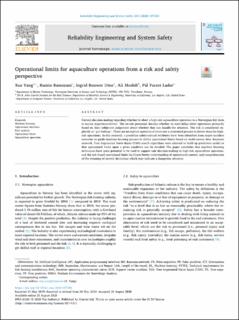| dc.contributor.author | Yang, Xue | |
| dc.contributor.author | Ramezani, Ramin | |
| dc.contributor.author | Utne, Ingrid Bouwer | |
| dc.contributor.author | Mosleh, Ali | |
| dc.contributor.author | Lader, Pål Furset | |
| dc.date.accessioned | 2020-09-29T11:18:21Z | |
| dc.date.available | 2020-09-29T11:18:21Z | |
| dc.date.created | 2020-09-10T13:46:48Z | |
| dc.date.issued | 2020 | |
| dc.identifier.citation | Reliability Engineering & System Safety. 2020, 204 . | en_US |
| dc.identifier.issn | 0951-8320 | |
| dc.identifier.uri | https://hdl.handle.net/11250/2680263 | |
| dc.description.abstract | Current decision making regarding whether to abort a high-risk aquaculture operation in a Norwegian fish farm is mainly experience-driven. The on-site personnel decides whether to start/delay/abort operations primarily based on their subjective judgement about whether they can handle the situation. The risk is considered implicitly as “gut feelings”. There are no explicit operational limits nor a structured process to derive these for high-risk operations. In this research, a predefine safety-critical attributes have been identified from major accident scenarios to guide machine learning process to define operational limits based on multi-source data. Bayesian network, Tree Augmented Naïve Bayes (TAN) search algorithms were selected to build up prediction model so that operational limits upon a given condition can be decided. The paper concludes that machine learning techniques have great potential to be used to support safe decision-making in high-risk aquaculture operation, and the risk-based operational limits facilitates better understanding of operational context, and comprehension of the meaning of several deviations which may indicate a dangerous situation. | en_US |
| dc.language.iso | eng | en_US |
| dc.publisher | Elsevier | en_US |
| dc.rights | Navngivelse 4.0 Internasjonal | * |
| dc.rights.uri | http://creativecommons.org/licenses/by/4.0/deed.no | * |
| dc.title | Operational limits for aquaculture operations from a risk and safety perspective | en_US |
| dc.type | Peer reviewed | en_US |
| dc.type | Journal article | en_US |
| dc.description.version | publishedVersion | en_US |
| dc.source.pagenumber | 11 | en_US |
| dc.source.volume | 204 | en_US |
| dc.source.journal | Reliability Engineering & System Safety | en_US |
| dc.identifier.doi | 10.1016/j.ress.2020.107208 | |
| dc.identifier.cristin | 1828762 | |
| dc.relation.project | Norges forskningsråd: 254913 | en_US |
| dc.description.localcode | This is an open access article distributed under the terms of the Creative Commons CC-BY license, which permits unrestricted use, distribution, and reproduction in any medium, provided the original work is properly cited. | en_US |
| cristin.ispublished | true | |
| cristin.fulltext | postprint | |
| cristin.qualitycode | 2 | |

